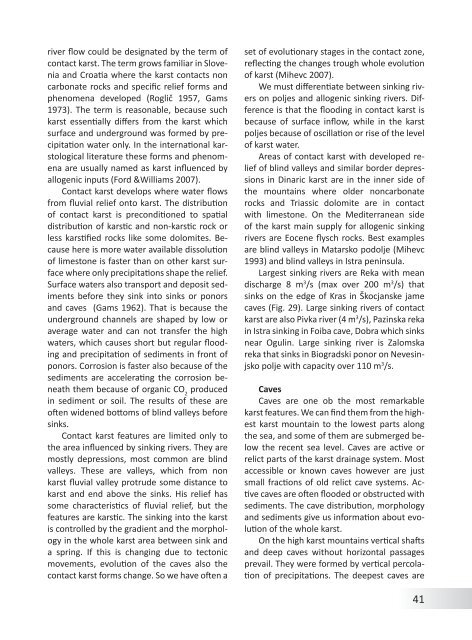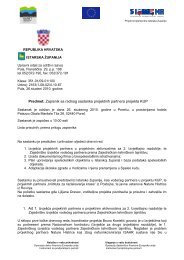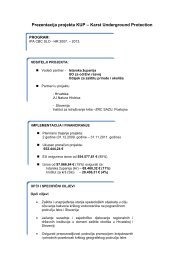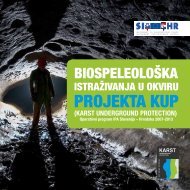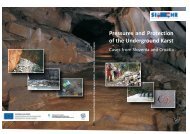Case Studies from the Dinaric Karst of Slovenia
Case Studies from the Dinaric Karst of Slovenia
Case Studies from the Dinaric Karst of Slovenia
You also want an ePaper? Increase the reach of your titles
YUMPU automatically turns print PDFs into web optimized ePapers that Google loves.
iver flow could be designated by <strong>the</strong> term <strong>of</strong>contact karst. The term grows familiar in <strong>Slovenia</strong>and Croatia where <strong>the</strong> karst contacts noncarbonate rocks and specific relief forms andphenomena developed (Roglič 1957, Gams1973). The term is reasonable, because suchkarst essentially differs <strong>from</strong> <strong>the</strong> karst whichsurface and underground was formed by precipitationwater only. In <strong>the</strong> international karstologicalliterature <strong>the</strong>se forms and phenomenaare usually named as karst influenced byallogenic inputs (Ford &Williams 2007).Contact karst develops where water flows<strong>from</strong> fluvial relief onto karst. The distribution<strong>of</strong> contact karst is preconditioned to spatialdistribution <strong>of</strong> karstic and non-karstic rock orless karstified rocks like some dolomites. Becausehere is more water available dissolution<strong>of</strong> limestone is faster than on o<strong>the</strong>r karst surfacewhere only precipitations shape <strong>the</strong> relief.Surface waters also transport and deposit sedimentsbefore <strong>the</strong>y sink into sinks or ponorsand caves (Gams 1962). That is because <strong>the</strong>underground channels are shaped by low oraverage water and can not transfer <strong>the</strong> highwaters, which causes short but regular floodingand precipitation <strong>of</strong> sediments in front <strong>of</strong>ponors. Corrosion is faster also because <strong>of</strong> <strong>the</strong>sediments are accelerating <strong>the</strong> corrosion beneath<strong>the</strong>m because <strong>of</strong> organic CO 2producedin sediment or soil. The results <strong>of</strong> <strong>the</strong>se are<strong>of</strong>ten widened bottoms <strong>of</strong> blind valleys beforesinks.Contact karst features are limited only to<strong>the</strong> area influenced by sinking rivers. They aremostly depressions, most common are blindvalleys. These are valleys, which <strong>from</strong> nonkarst fluvial valley protrude some distance tokarst and end above <strong>the</strong> sinks. His relief hassome characteristics <strong>of</strong> fluvial relief, but <strong>the</strong>features are karstic. The sinking into <strong>the</strong> karstis controlled by <strong>the</strong> gradient and <strong>the</strong> morphologyin <strong>the</strong> whole karst area between sink anda spring. If this is changing due to tectonicmovements, evolution <strong>of</strong> <strong>the</strong> caves also <strong>the</strong>contact karst forms change. So we have <strong>of</strong>ten aset <strong>of</strong> evolutionary stages in <strong>the</strong> contact zone,reflecting <strong>the</strong> changes trough whole evolution<strong>of</strong> karst (Mihevc 2007).We must differentiate between sinking riverson poljes and allogenic sinking rivers. Differenceis that <strong>the</strong> flooding in contact karst isbecause <strong>of</strong> surface inflow, while in <strong>the</strong> karstpoljes because <strong>of</strong> oscillation or rise <strong>of</strong> <strong>the</strong> level<strong>of</strong> karst water.Areas <strong>of</strong> contact karst with developed relief<strong>of</strong> blind valleys and similar border depressionsin <strong>Dinaric</strong> karst are in <strong>the</strong> inner side <strong>of</strong><strong>the</strong> mountains where older noncarbonaterocks and Triassic dolomite are in contactwith limestone. On <strong>the</strong> Mediterranean side<strong>of</strong> <strong>the</strong> karst main supply for allogenic sinkingrivers are Eocene flysch rocks. Best examplesare blind valleys in Matarsko podolje (Mihevc1993) and blind valleys in Istra peninsula.Largest sinking rivers are Reka with meandischarge 8 m 3 /s (max over 200 m 3 /s) thatsinks on <strong>the</strong> edge <strong>of</strong> Kras in Škocjanske jamecaves (Fig. 29). Large sinking rivers <strong>of</strong> contactkarst are also Pivka river (4 m 3 /s), Pazinska rekain Istra sinking in Foiba cave, Dobra which sinksnear Ogulin. Large sinking river is Zalomskareka that sinks in Biogradski ponor on Nevesinjskopolje with capacity over 110 m 3 /s.CavesCaves are one ob <strong>the</strong> most remarkablekarst features. We can find <strong>the</strong>m <strong>from</strong> <strong>the</strong> highestkarst mountain to <strong>the</strong> lowest parts along<strong>the</strong> sea, and some <strong>of</strong> <strong>the</strong>m are submerged below<strong>the</strong> recent sea level. Caves are active orrelict parts <strong>of</strong> <strong>the</strong> karst drainage system. Mostaccessible or known caves however are justsmall fractions <strong>of</strong> old relict cave systems. Activecaves are <strong>of</strong>ten flooded or obstructed withsediments. The cave distribution, morphologyand sediments give us information about evolution<strong>of</strong> <strong>the</strong> whole karst.On <strong>the</strong> high karst mountains vertical shaftsand deep caves without horizontal passagesprevail. They were formed by vertical percolation<strong>of</strong> precipitations. The deepest caves are41


